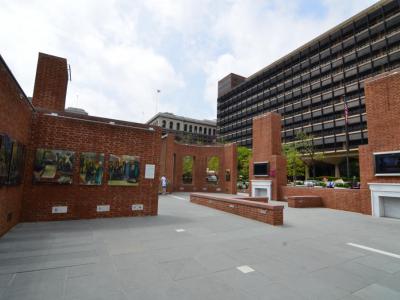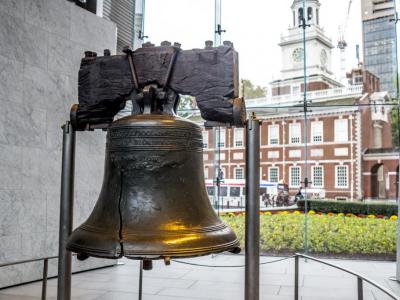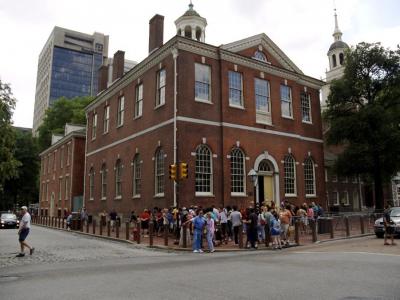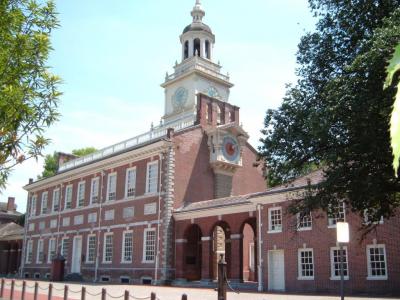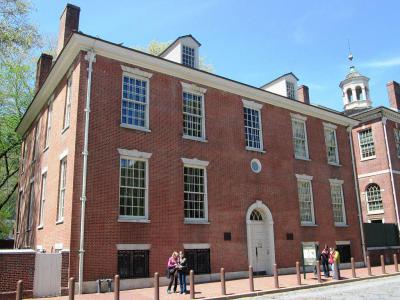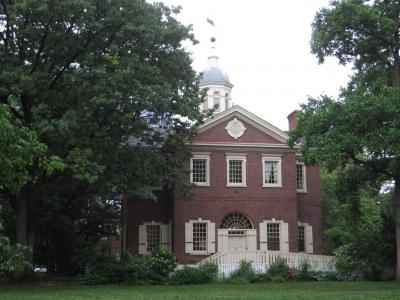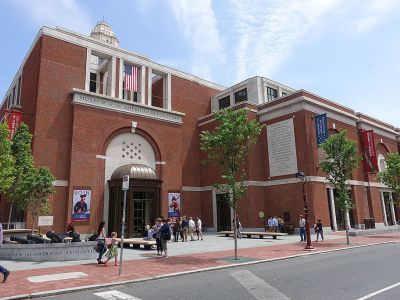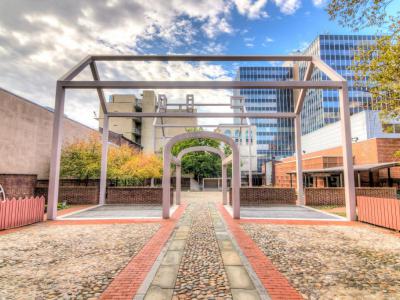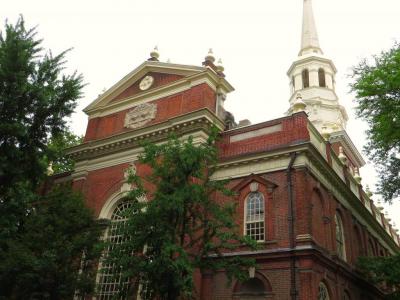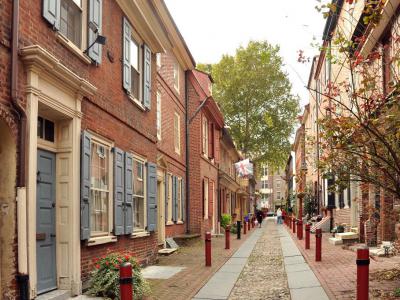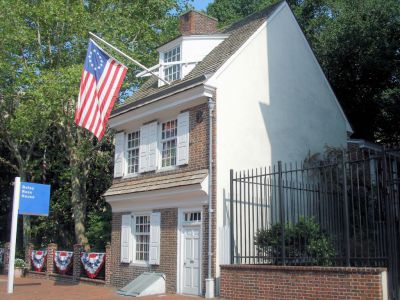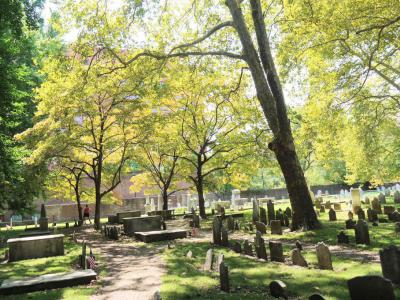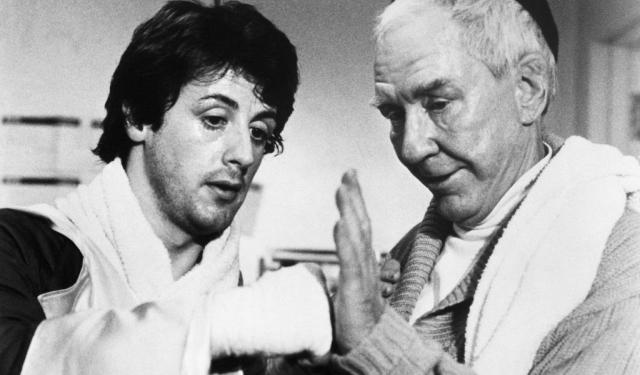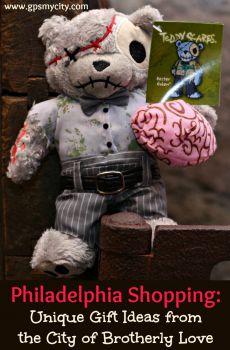Audio Guide: Philadelphia Introduction Walking Tour (Self Guided), Philadelphia
The sixth largest city in the United States and the largest in the Commonwealth of Pennsylvania, Philadelphia is a dynamic city heaped with old-world charm and contemporary infrastructure. Notable for its rich history, primarily as the birthplace of "life, liberty, and the pursuit of happiness."
Often called Philly, Philadelphia is also known as the City of Brotherly Love – a combination of two Greek words: love (phileo) and brother (adelphos). Its founder, English Quaker William Penn, envisioned a city of religious tolerance where everyone was free to practice their religion without fear of persecution. Pursuant to this goal, he made treaties with the Native Americans living on the land to ensure peace.
Prior to the arrival of Europeans, the area was inhabited by the Lenape (Delaware) Indians. The first European colony, founded by the Dutch in the early 17th century and known as New Netherland, was captured by an English fleet in 1664. 1682 is considered the year of Philadelphia's foundation when the area was included in William Penn's charter for Pennsylvania which was granted to him by King Charles II of England a year earlier.
The city served as the capital of the Pennsylvania Colony during the British colonial era and went on to play a vital role in the 18th century as the central meeting place for the nation's founding fathers whose plans and actions ultimately inspired and resulted in the American Revolution. Philadelphia hosted the First Continental Congress in 1774, preserved the Liberty Bell, and hosted the Second Continental Congress during which the Declaration of Independence was signed in what's now known as Independence Hall.
The U.S. Constitution was later ratified at the Philadelphia Convention of 1787. The city remained the nation's largest until 1790, and served as its first capital, from May 10, 1775 until December 12, 1776, and on four subsequent occasions during and following the American Revolution.
The architectural history of Philadelphia, started in colonial times, includes a wide range of styles. During the 18th century, the cityscape was dominated by Georgian architecture, seen in the likes of Christ Church.
In the 19th century, the city became a key national industrial center and railroad hub flooded by immigrants, first Europeans and then African Americans who came from the South. In the 20th century, Philadelphia enjoyed further vitalization and gentrification of neighborhoods.
To explore the most famous sights of Philadelphia, some of which have seen actions that shaped the United States as we know today, take this self-guided walk!
Often called Philly, Philadelphia is also known as the City of Brotherly Love – a combination of two Greek words: love (phileo) and brother (adelphos). Its founder, English Quaker William Penn, envisioned a city of religious tolerance where everyone was free to practice their religion without fear of persecution. Pursuant to this goal, he made treaties with the Native Americans living on the land to ensure peace.
Prior to the arrival of Europeans, the area was inhabited by the Lenape (Delaware) Indians. The first European colony, founded by the Dutch in the early 17th century and known as New Netherland, was captured by an English fleet in 1664. 1682 is considered the year of Philadelphia's foundation when the area was included in William Penn's charter for Pennsylvania which was granted to him by King Charles II of England a year earlier.
The city served as the capital of the Pennsylvania Colony during the British colonial era and went on to play a vital role in the 18th century as the central meeting place for the nation's founding fathers whose plans and actions ultimately inspired and resulted in the American Revolution. Philadelphia hosted the First Continental Congress in 1774, preserved the Liberty Bell, and hosted the Second Continental Congress during which the Declaration of Independence was signed in what's now known as Independence Hall.
The U.S. Constitution was later ratified at the Philadelphia Convention of 1787. The city remained the nation's largest until 1790, and served as its first capital, from May 10, 1775 until December 12, 1776, and on four subsequent occasions during and following the American Revolution.
The architectural history of Philadelphia, started in colonial times, includes a wide range of styles. During the 18th century, the cityscape was dominated by Georgian architecture, seen in the likes of Christ Church.
In the 19th century, the city became a key national industrial center and railroad hub flooded by immigrants, first Europeans and then African Americans who came from the South. In the 20th century, Philadelphia enjoyed further vitalization and gentrification of neighborhoods.
To explore the most famous sights of Philadelphia, some of which have seen actions that shaped the United States as we know today, take this self-guided walk!
How it works: Download the app "GPSmyCity: Walks in 1K+ Cities" from Apple App Store or Google Play Store to your mobile phone or tablet. The app turns your mobile device into a personal tour guide and its built-in GPS navigation functions guide you from one tour stop to next. The app works offline, so no data plan is needed when traveling abroad.
Philadelphia Introduction Walking Tour Map
Guide Name: Philadelphia Introduction Walking Tour
Guide Location: USA » Philadelphia (See other walking tours in Philadelphia)
Guide Type: Self-guided Walking Tour (Sightseeing)
# of Attractions: 12
Tour Duration: 2 Hour(s)
Travel Distance: 2.3 Km or 1.4 Miles
Author: leticia
Sight(s) Featured in This Guide:
Guide Location: USA » Philadelphia (See other walking tours in Philadelphia)
Guide Type: Self-guided Walking Tour (Sightseeing)
# of Attractions: 12
Tour Duration: 2 Hour(s)
Travel Distance: 2.3 Km or 1.4 Miles
Author: leticia
Sight(s) Featured in This Guide:
- President's House
- Liberty Bell
- Congress Hall
- Independence Hall
- Philosophical Hall
- Carpenters' Hall
- Museum of the American Revolution
- Benjamin Franklin Museum and Court
- Christ Church
- Elfreth's Alley
- Betsy Ross House
- Christ Church Burial Ground
1) President's House
The President's House in Philadelphia holds a unique place in American history as the third U.S. Presidential Mansion and a pivotal site during the nation's early years. Occupied by George Washington from November 27, 1790, to March 10, 1797, and by John Adams from March 21, 1797, to May 30, 1800, this residence served as the executive mansion before the White House was completed.
Constructed around 1767 by Mary Masters, a widow, the house was situated just one block north of the Pennsylvania Statehouse, now known as Independence Hall. It briefly played a significant role during the British occupation of Philadelphia in 1777–1778, serving as headquarters for General Sir William Howe and the British Army. After the British evacuated in June 1778, the house became the headquarters for Military Governor Benedict Arnold.
Philadelphia was the national capital from 1790 to 1800, a period during which the city was the heart of American political life. The house was owned by Robert Morris, a financier of the Revolutionary War and a Founding Father, who provided it for George Washington's use. Reflecting the complexities of the era, Washington brought nine enslaved Africans from his Mount Vernon estate to work in the presidential household, a fact that underscores the entwined histories of freedom and slavery in the United States.
However, the exact location of The President's House was forgotten over time, leading to the unintentional demolition of its surviving walls in 1951. This loss sparked a significant historical and cultural reassessment, culminating in the 2010 commemoration of the site. This effort was driven by historians and African American groups, who advocated for the recognition of the house's complex legacy, including its role in the history of slavery in the United States.
Constructed around 1767 by Mary Masters, a widow, the house was situated just one block north of the Pennsylvania Statehouse, now known as Independence Hall. It briefly played a significant role during the British occupation of Philadelphia in 1777–1778, serving as headquarters for General Sir William Howe and the British Army. After the British evacuated in June 1778, the house became the headquarters for Military Governor Benedict Arnold.
Philadelphia was the national capital from 1790 to 1800, a period during which the city was the heart of American political life. The house was owned by Robert Morris, a financier of the Revolutionary War and a Founding Father, who provided it for George Washington's use. Reflecting the complexities of the era, Washington brought nine enslaved Africans from his Mount Vernon estate to work in the presidential household, a fact that underscores the entwined histories of freedom and slavery in the United States.
However, the exact location of The President's House was forgotten over time, leading to the unintentional demolition of its surviving walls in 1951. This loss sparked a significant historical and cultural reassessment, culminating in the 2010 commemoration of the site. This effort was driven by historians and African American groups, who advocated for the recognition of the house's complex legacy, including its role in the history of slavery in the United States.
2) Liberty Bell (must see)
The Liberty Bell, an iconic symbol of American freedom and independence, has a rich and storied history closely tied to Philadelphia, Pennsylvania. Cast in 1752 by the Whitechapel Bell Foundry in London, England, the bell was originally commissioned to mark the 50th anniversary of Pennsylvania's original constitution and to symbolize the ideals of liberty and justice.
Initially hung in the Pennsylvania State House (now known as Independence Hall), the bell gained fame not only for its impressive size and sound but also for its role in important historical events. One popular but apocryphal story links the Liberty Bell to the reading of the Declaration of Independence on July 4, 1776, claiming that it rang out to announce the birth of the new nation. While there is no historical evidence to support this specific event, the bell did gain significance as a symbol of American independence in the ensuing decades.
The bell's inscription, "Proclaim LIBERTY Throughout all the Land unto all the Inhabitants Thereof," from the Bible, became its defining feature and a powerful statement in support of abolitionist movements in the 19th century. Its association with the abolitionist cause led to the bell being dubbed the "Liberty Bell" around the 1830s.
By the mid-19th century, as the bell's structural integrity deteriorated, it was retired from active service. In 1852, it was moved to a pavilion near Independence Hall where it became an object of public veneration. During World War II, the bell's iconic status was further solidified as it was used as a symbol of liberty and freedom, inspiring war bond drives and patriotic sentiment.
Today, the Liberty Bell is housed in the Liberty Bell Center, part of Independence National Historical Park in Philadelphia. It continues to attract millions of visitors each year who come to see and reflect upon its enduring message of liberty, justice, and the ongoing struggle for equality.
Initially hung in the Pennsylvania State House (now known as Independence Hall), the bell gained fame not only for its impressive size and sound but also for its role in important historical events. One popular but apocryphal story links the Liberty Bell to the reading of the Declaration of Independence on July 4, 1776, claiming that it rang out to announce the birth of the new nation. While there is no historical evidence to support this specific event, the bell did gain significance as a symbol of American independence in the ensuing decades.
The bell's inscription, "Proclaim LIBERTY Throughout all the Land unto all the Inhabitants Thereof," from the Bible, became its defining feature and a powerful statement in support of abolitionist movements in the 19th century. Its association with the abolitionist cause led to the bell being dubbed the "Liberty Bell" around the 1830s.
By the mid-19th century, as the bell's structural integrity deteriorated, it was retired from active service. In 1852, it was moved to a pavilion near Independence Hall where it became an object of public veneration. During World War II, the bell's iconic status was further solidified as it was used as a symbol of liberty and freedom, inspiring war bond drives and patriotic sentiment.
Today, the Liberty Bell is housed in the Liberty Bell Center, part of Independence National Historical Park in Philadelphia. It continues to attract millions of visitors each year who come to see and reflect upon its enduring message of liberty, justice, and the ongoing struggle for equality.
3) Congress Hall
Congress Hall, a significant landmark in Philadelphia, is situated at the intersection of Chestnut and 6th Streets. Notably, it served as the seat of the United States Congress from December 6, 1790, to May 14, 1800. During this decade, Philadelphia was the temporary capital of the United States.
The building's architecture and use reflect the formative years of the U.S. government. The House of Representatives convened on the first floor, while the Senate met upstairs. This period in Congress Hall was marked by pivotal moments in American history, including the inauguration of Presidents George Washington (for his second term) and John Adams.
The first floor, home to the House chamber, features a simple design with mahogany desks and leather chairs. By 1796, it accommodated 106 representatives from 16 states, including the original 13, plus Vermont in 1791, Kentucky in 1792, and Tennessee in 1796. This room has been meticulously restored to its 1796 condition.
In contrast, the Senate chamber on the second floor is more elaborate. It was adorned with heavy red drapes and, by 1796, equipped with 32 secretary desks, 28 of which are original and akin to those in the current Senate chamber at the United States Capitol. The room also displays portraits of Louis XVI and Marie Antoinette, gifts from France post-Revolution. Noteworthy features include a ceiling fresco of an American bald eagle, symbolizing peace, and a plaster medallion depicting a sunburst with 13 stars for the original colonies.
The building's architecture and use reflect the formative years of the U.S. government. The House of Representatives convened on the first floor, while the Senate met upstairs. This period in Congress Hall was marked by pivotal moments in American history, including the inauguration of Presidents George Washington (for his second term) and John Adams.
The first floor, home to the House chamber, features a simple design with mahogany desks and leather chairs. By 1796, it accommodated 106 representatives from 16 states, including the original 13, plus Vermont in 1791, Kentucky in 1792, and Tennessee in 1796. This room has been meticulously restored to its 1796 condition.
In contrast, the Senate chamber on the second floor is more elaborate. It was adorned with heavy red drapes and, by 1796, equipped with 32 secretary desks, 28 of which are original and akin to those in the current Senate chamber at the United States Capitol. The room also displays portraits of Louis XVI and Marie Antoinette, gifts from France post-Revolution. Noteworthy features include a ceiling fresco of an American bald eagle, symbolizing peace, and a plaster medallion depicting a sunburst with 13 stars for the original colonies.
4) Independence Hall (must see)
By the late 1720s, Philadelphia was in need of a state house. The ground for its construction – on the south side of Chestnut Street, between Fifth and Sixth Streets, to a design by architect Edmund Woolley – was broken in 1732.
Upon its completion in 1753, the Colonial Government of Pennsylvania took occupancy of the State House immediately. The building served as the Capitol of the Province and Commonwealth of Pennsylvania until 1799.
The former Pennsylvania State House, now known as Independence Hall, is a Georgian-style hall with a red brick facade. There is a central building with a bell tower and steeple. The center is attached by arcaded passageways to wings on either side. The steeple spire is 169 feet high. Old City Hall, Congress Hall, and Independence Hall together with Philosophical Hall, share Independence Square.
The Hall underwent several renovations in the 19th and 20th centuries ultimately restoring its 18th-century appearance. On the ground floor are the Assembly Room and the Supreme Court Room, separated by a vestibule. Behind the entrance is the Tower Stair Hall.
On June 14, 1775, the delegates of the Continental Congress chose George Washington to serve as the commander-in-chief of the Continental Army in the Assembly Room of the Independence Hall. Later, on July 26, the Congress named Benjamin Franklin as the first Postmaster General, a position that eventually evolved into the United States Post Office Department.
From 1775 to 1783, the Independence Hall was the main meeting house of the Second Continental Congress. The Declaration of Independence was approved within its walls on July 4, 1776. The United States Constitution was approved here in 1787.
Ever since then, Independence Hall has often served as a venue for speeches, rallies, and protests. Most events have been held on behalf of democratic and civil rights movements.
Upon its completion in 1753, the Colonial Government of Pennsylvania took occupancy of the State House immediately. The building served as the Capitol of the Province and Commonwealth of Pennsylvania until 1799.
The former Pennsylvania State House, now known as Independence Hall, is a Georgian-style hall with a red brick facade. There is a central building with a bell tower and steeple. The center is attached by arcaded passageways to wings on either side. The steeple spire is 169 feet high. Old City Hall, Congress Hall, and Independence Hall together with Philosophical Hall, share Independence Square.
The Hall underwent several renovations in the 19th and 20th centuries ultimately restoring its 18th-century appearance. On the ground floor are the Assembly Room and the Supreme Court Room, separated by a vestibule. Behind the entrance is the Tower Stair Hall.
On June 14, 1775, the delegates of the Continental Congress chose George Washington to serve as the commander-in-chief of the Continental Army in the Assembly Room of the Independence Hall. Later, on July 26, the Congress named Benjamin Franklin as the first Postmaster General, a position that eventually evolved into the United States Post Office Department.
From 1775 to 1783, the Independence Hall was the main meeting house of the Second Continental Congress. The Declaration of Independence was approved within its walls on July 4, 1776. The United States Constitution was approved here in 1787.
Ever since then, Independence Hall has often served as a venue for speeches, rallies, and protests. Most events have been held on behalf of democratic and civil rights movements.
5) Philosophical Hall
Philosophical Hall, a historic landmark in Philadelphia, has been the epicenter of intellectual and scientific discourse for over two centuries as the headquarters of the American Philosophical Society (APS). This society, established in 1743, initially lacked a permanent meeting place, leading its members to convene in various locations across Philadelphia. It was not until 1783, forty years after its inception, that the APS members resolved to build a dedicated space for their gatherings.
Their initial consideration was a lot near Arch Street, but fate had a different plan. A lot in the State House yard, now known as Independence Square and adjacent to the renowned Independence Hall, became available. Recognizing the significance of this location, the Pennsylvania Legislative Assembly generously granted this lot to the Society in 1785.
This auspicious beginning marked the start of a challenging journey to erect Philosophical Hall. The Society immediately embarked on the construction, beginning with the excavation of the cellar. However, financial constraints slowed down the progress, stretching the construction period to four years. It was during this time that Benjamin Franklin, a notable member of the Society, stepped in with a crucial loan, providing the final financial push needed to complete the building.
Since its completion, Philosophical Hall has stood as a symbol of the American commitment to intellectual pursuit and scientific inquiry, standing in close proximity to Independence Hall, a site of immense historical significance in the United States. The Hall not only represents the enduring legacy of the APS but also serves as a testament to the collaborative spirit and determination of its founding members, including the likes of Benjamin Franklin.
Their initial consideration was a lot near Arch Street, but fate had a different plan. A lot in the State House yard, now known as Independence Square and adjacent to the renowned Independence Hall, became available. Recognizing the significance of this location, the Pennsylvania Legislative Assembly generously granted this lot to the Society in 1785.
This auspicious beginning marked the start of a challenging journey to erect Philosophical Hall. The Society immediately embarked on the construction, beginning with the excavation of the cellar. However, financial constraints slowed down the progress, stretching the construction period to four years. It was during this time that Benjamin Franklin, a notable member of the Society, stepped in with a crucial loan, providing the final financial push needed to complete the building.
Since its completion, Philosophical Hall has stood as a symbol of the American commitment to intellectual pursuit and scientific inquiry, standing in close proximity to Independence Hall, a site of immense historical significance in the United States. The Hall not only represents the enduring legacy of the APS but also serves as a testament to the collaborative spirit and determination of its founding members, including the likes of Benjamin Franklin.
6) Carpenters' Hall
Everyone knows about the Second Continental Congress, which signed the Declaration of Independence at Independence Hall. Still, hardly anyone ever talks about the First Continental Congress, which marked a pivotal moment in the lead-up to the American Revolution. It was the first time that the 13 Colonies got together in one spot in defiance of British rule.
Carpenters' Hall was completed in 1773 by the Carpenters' Company of the City and County of Philadelphia, a guild or trade association established in 1724. Architect Robert Smith designed the Hall in the Georgian style, reflecting the architectural preferences of the time.
In 1774, Carpenters' Hall hosted the First Continental Congress from September 5 to October 26. Delegates from 12 of the 13 American colonies (Georgia did not send delegates) gathered to discuss grievances against British policies and to coordinate a united response. Within these walls, key decisions were made, including drafting a unified statement of rights and grievances addressed to King George III.
Notably, Carpenters' Hall was the site of clandestine meetings, such as those between Benjamin Franklin and others, who secretly met with French contacts to discuss French support for the American Revolution.
After the First Continental Congress, Carpenters' Hall was a meeting place for various organizations and events. The Second Continental Congress briefly used it in 1775 before it moved to Independence Hall. The Hall saw multiple uses throughout the 19th and early 20th centuries, including as a bank and a library.
The building was designated a National Historic Landmark on April 15, 1970. Today, Carpenters' Hall is open to the public as a historic site.
Carpenters' Hall was completed in 1773 by the Carpenters' Company of the City and County of Philadelphia, a guild or trade association established in 1724. Architect Robert Smith designed the Hall in the Georgian style, reflecting the architectural preferences of the time.
In 1774, Carpenters' Hall hosted the First Continental Congress from September 5 to October 26. Delegates from 12 of the 13 American colonies (Georgia did not send delegates) gathered to discuss grievances against British policies and to coordinate a united response. Within these walls, key decisions were made, including drafting a unified statement of rights and grievances addressed to King George III.
Notably, Carpenters' Hall was the site of clandestine meetings, such as those between Benjamin Franklin and others, who secretly met with French contacts to discuss French support for the American Revolution.
After the First Continental Congress, Carpenters' Hall was a meeting place for various organizations and events. The Second Continental Congress briefly used it in 1775 before it moved to Independence Hall. The Hall saw multiple uses throughout the 19th and early 20th centuries, including as a bank and a library.
The building was designated a National Historic Landmark on April 15, 1970. Today, Carpenters' Hall is open to the public as a historic site.
7) Museum of the American Revolution (must see)
The Museum of the American Revolution, located in Philadelphia, is dedicated to chronicling the story of the American Revolution. This institution, originally known as The American Revolution Center, opened its doors to the public on April 19, 2017. This date holds particular historical importance as it marks the 242nd anniversary of the Battles of Lexington and Concord, pivotal conflicts in the American Revolutionary War that occurred on April 19, 1775.
The Museum of the American Revolution boasts a vast collection of several thousand artifacts, forming a rich tapestry of the nation's history. Among its prized possessions are items personally owned and used by General George Washington during the War of Independence. The collection is also renowned for its extensive array of historic firearms, edged weapons, significant art, invaluable manuscripts, and rare books. A notable part of this collection originated from the early 20th-century efforts of Rev. W. Herbert Burk, forming the core of the museum's offerings.
The current building was unveiled in 2012 with 32,000 square feet dedicated to exhibits and interpretive spaces. The first floor, which houses a museum shop and the Cross Keys Café, is built around a skylit central interior court. It also features a cross-vaulted ticketing lobby, a multi-use theater, and a gallery for changing exhibitions. The second floor is home to 18,000 square feet of galleries, including a theater showcasing George Washington's marquee tent.
The third floor of the museum offers event spaces and two terraces with views of the Independence National Historical Park and the Philadelphia skyline.
Tip:
The museum's highlight is the tent used by George Washington during the independence war. Check what times the presentation is playing, and make sure to show up a little bit early, as the theater is not large and fills up quickly.
The Museum of the American Revolution boasts a vast collection of several thousand artifacts, forming a rich tapestry of the nation's history. Among its prized possessions are items personally owned and used by General George Washington during the War of Independence. The collection is also renowned for its extensive array of historic firearms, edged weapons, significant art, invaluable manuscripts, and rare books. A notable part of this collection originated from the early 20th-century efforts of Rev. W. Herbert Burk, forming the core of the museum's offerings.
The current building was unveiled in 2012 with 32,000 square feet dedicated to exhibits and interpretive spaces. The first floor, which houses a museum shop and the Cross Keys Café, is built around a skylit central interior court. It also features a cross-vaulted ticketing lobby, a multi-use theater, and a gallery for changing exhibitions. The second floor is home to 18,000 square feet of galleries, including a theater showcasing George Washington's marquee tent.
The third floor of the museum offers event spaces and two terraces with views of the Independence National Historical Park and the Philadelphia skyline.
Tip:
The museum's highlight is the tent used by George Washington during the independence war. Check what times the presentation is playing, and make sure to show up a little bit early, as the theater is not large and fills up quickly.
8) Benjamin Franklin Museum and Court
The Benjamin Franklin Museum lies in the fully-enclosed courtyard where the Founding Father's house and print shop once stood. Although these were torn down long ago, some archaeological remains were excavated and are visible beneath glass windows in the ground along with explanatory signs.
"Ghost" houses were built in the exact spots where the house and print shop once stood, so one gets a real sense of how the site would have looked when those structures were standing. There is also a working 18th-century print shop adjacent which is a neat experience.
It doesn't cost anything to walk through Franklin Court, view the "ghost" houses, or visit the working print shop. The museum costs a very reasonable fee. While the space is not huge, it provides a very thorough and interesting overview of Franklin's life and contributions to the country. There are lots of interactive objects for kids and fascinating things to see, read, and ponder for adults.
The visitors can get both an overview of Franklin's life, as well as little interesting tidbits of trivia about him. They even have entertaining videos illustrating some humorous (and informative) episodes in his life, which seem to be everyone's favorite part. All in all, there is something for everyone, regardless of age.
"Ghost" houses were built in the exact spots where the house and print shop once stood, so one gets a real sense of how the site would have looked when those structures were standing. There is also a working 18th-century print shop adjacent which is a neat experience.
It doesn't cost anything to walk through Franklin Court, view the "ghost" houses, or visit the working print shop. The museum costs a very reasonable fee. While the space is not huge, it provides a very thorough and interesting overview of Franklin's life and contributions to the country. There are lots of interactive objects for kids and fascinating things to see, read, and ponder for adults.
The visitors can get both an overview of Franklin's life, as well as little interesting tidbits of trivia about him. They even have entertaining videos illustrating some humorous (and informative) episodes in his life, which seem to be everyone's favorite part. All in all, there is something for everyone, regardless of age.
9) Christ Church (must see)
Christ Church in Philadelphia, established in 1695 by the Church of England, quickly became a pivotal religious and historical site. A year later, the congregation erected their first wooden structure, but due to rapid growth, they built a grander temple in the 1720s, the most sumptuous in the Thirteen Colonies.
Christ Church's congregation included 15 signers of the Declaration of Independence, hence it is often called the "Nation's Church". Noteworthy American Revolutionary War leaders like George Washington, Robert Morris, Benjamin Franklin, and Betsy Ross attended this church. Brass plaques mark the pews where they once sat. Washington's pew is #56, Franklin's pew is #70, and Betsy Ross's pew is #12.
Among other things, this church is also celebrated for its stunning Georgian architecture, influenced by Christopher Wren's designs in London. It features a symmetrical facade, arched windows, and a beautifully simple interior characterized by fluted columns and wooden pews. Uniquely, the church has clear windows instead of the traditional stained glass, filling the interior with natural light and views of the surroundings.
Constructed primarily between 1727 and 1744, with its steeple added in 1754, Christ Church stood the tallest building in the future United States for over fifty years. The church underwent significant modifications with a rebuild in 1777 and interior alterations in 1883.
The churchyard is the final resting place of prominent figures such as two signers of the Declaration of Independence, Robert Morris and James Wilson. Christ Church remains a vibrant Episcopal parish and a National Historic Landmark, attracting over 250,000 visitors annually. On-site docents are always there to answer questions, should you have any.
Tip:
Don't miss the collection of historical artifacts, including the 14th-century baptismal font in which William Penn (founder of the Province of Pennsylvania) was baptized, along with a rare book collection and communion elements crafted in the 1790s.
Christ Church's congregation included 15 signers of the Declaration of Independence, hence it is often called the "Nation's Church". Noteworthy American Revolutionary War leaders like George Washington, Robert Morris, Benjamin Franklin, and Betsy Ross attended this church. Brass plaques mark the pews where they once sat. Washington's pew is #56, Franklin's pew is #70, and Betsy Ross's pew is #12.
Among other things, this church is also celebrated for its stunning Georgian architecture, influenced by Christopher Wren's designs in London. It features a symmetrical facade, arched windows, and a beautifully simple interior characterized by fluted columns and wooden pews. Uniquely, the church has clear windows instead of the traditional stained glass, filling the interior with natural light and views of the surroundings.
Constructed primarily between 1727 and 1744, with its steeple added in 1754, Christ Church stood the tallest building in the future United States for over fifty years. The church underwent significant modifications with a rebuild in 1777 and interior alterations in 1883.
The churchyard is the final resting place of prominent figures such as two signers of the Declaration of Independence, Robert Morris and James Wilson. Christ Church remains a vibrant Episcopal parish and a National Historic Landmark, attracting over 250,000 visitors annually. On-site docents are always there to answer questions, should you have any.
Tip:
Don't miss the collection of historical artifacts, including the 14th-century baptismal font in which William Penn (founder of the Province of Pennsylvania) was baptized, along with a rare book collection and communion elements crafted in the 1790s.
10) Elfreth's Alley (must see)
In the 18th century, Philadelphia became a bustling city, overcrowded with artisans, tradesmen, shipwrights, metalsmiths, glassblowers, and furniture makers. As a result, the landowners Arthur Wells and John Gilbert started a cart path from Front Street to Second Street in 1703. The path became Elfreth's Alley, named after Jeremiah Elfreth, an 18th-century blacksmith and a man of property in young Philadelphia.
By the 1770s Georgian and Federal-style houses lined the cobblestone Alley. Many of the structures were uniquely Philadelphian Trinity houses. These were three-story houses, exceptionally narrow, with one room on each floor. The floors were referred to as "Father, Son, and Holy Ghost." And that is how Trinity houses got their name.
In the 19th and 20th centuries, the industry started to close in on the Alley. A stove factory took its place in a row of residential houses. Immigrants, hoping for jobs, came in waves. In 1934 the Elfreth's Alley Association (EAA) was founded by Alley resident Dolly Ottey. Ottey fought to combat the deterioration of the Alley by encroaching industry in the early 20th century.
Elfreth's Alley Museum is located in houses 124 and 126. The museum preserves the home of 18th-century dressmakers. Tour guides discuss other homes and inhabitants of the Alley. On "Fete Day" in early June, which celebrates Alley's diverse ethnic heritage, the residents open their homes. There are historical reenactments with drum and fife bands. The Alley also host events for the 4th of July, Oktoberfestivities, and Halloween.
By the 1770s Georgian and Federal-style houses lined the cobblestone Alley. Many of the structures were uniquely Philadelphian Trinity houses. These were three-story houses, exceptionally narrow, with one room on each floor. The floors were referred to as "Father, Son, and Holy Ghost." And that is how Trinity houses got their name.
In the 19th and 20th centuries, the industry started to close in on the Alley. A stove factory took its place in a row of residential houses. Immigrants, hoping for jobs, came in waves. In 1934 the Elfreth's Alley Association (EAA) was founded by Alley resident Dolly Ottey. Ottey fought to combat the deterioration of the Alley by encroaching industry in the early 20th century.
Elfreth's Alley Museum is located in houses 124 and 126. The museum preserves the home of 18th-century dressmakers. Tour guides discuss other homes and inhabitants of the Alley. On "Fete Day" in early June, which celebrates Alley's diverse ethnic heritage, the residents open their homes. There are historical reenactments with drum and fife bands. The Alley also host events for the 4th of July, Oktoberfestivities, and Halloween.
11) Betsy Ross House (must see)
The story goes that Mrs. Eizabeth Claypoole, also known as Betsy Ross, had a visit from George Washington in 1776. She persuaded him, some say, that a five-pointed star was better than a six-pointed star. Betsy was an upholsterer, and she had been making flags for the Pennsylvania Navy. Flags were her specialty.
True or not, this captivating tale was told by her grandsons, William and George Canby, in the 1870s. People loved it, and it became a popular national legend. Number 239 Arch Street in Philadelphia is where Betsy is said to have lived with her third husband, John Claypoole. The house is a restoration done by architect Richardson Okie in 1940.
The "Betsy Ross" house that stands today may have been the house used by Betsy for her business. The residence of Betsy and her husband was adjacent to the present house. The houses next door were demolished and turned into a courtyard.
Richardson Okie used materials from the demolished houses in his restoration. A brick structure was built behind the house. Windows and a dormer were replaced. The whole property was gifted to the city of Philadelphia in 1941. In 1974 the courtyard was provided with a fountain.
As part of the American Bicentennial of 1976, city authorities moved the remains of Betsy and her husband, John Claypoole. They were reinterred in the courtyard of the Betsy Ross House. Betsy is thought to have resided in the house from 1776 until 1779.
John Ross, Betsy's first husband, a member of the militia, died in a gunpowder explosion. Her second husband, Joseph Ashburn, a mariner captured by the British, died in prison in Plymouth, England. John Claypoole was a fellow prisoner. He knew Ashburn. Betsy married Claypoole in 1783.
The Betsy Ross House is traditionally the site of Philadelphia's celebration of Flag Day. This legendary woman lived and worked here for a few short years when the Great Experiment began. Whatever else she may have done, she made flags.
True or not, this captivating tale was told by her grandsons, William and George Canby, in the 1870s. People loved it, and it became a popular national legend. Number 239 Arch Street in Philadelphia is where Betsy is said to have lived with her third husband, John Claypoole. The house is a restoration done by architect Richardson Okie in 1940.
The "Betsy Ross" house that stands today may have been the house used by Betsy for her business. The residence of Betsy and her husband was adjacent to the present house. The houses next door were demolished and turned into a courtyard.
Richardson Okie used materials from the demolished houses in his restoration. A brick structure was built behind the house. Windows and a dormer were replaced. The whole property was gifted to the city of Philadelphia in 1941. In 1974 the courtyard was provided with a fountain.
As part of the American Bicentennial of 1976, city authorities moved the remains of Betsy and her husband, John Claypoole. They were reinterred in the courtyard of the Betsy Ross House. Betsy is thought to have resided in the house from 1776 until 1779.
John Ross, Betsy's first husband, a member of the militia, died in a gunpowder explosion. Her second husband, Joseph Ashburn, a mariner captured by the British, died in prison in Plymouth, England. John Claypoole was a fellow prisoner. He knew Ashburn. Betsy married Claypoole in 1783.
The Betsy Ross House is traditionally the site of Philadelphia's celebration of Flag Day. This legendary woman lived and worked here for a few short years when the Great Experiment began. Whatever else she may have done, she made flags.
12) Christ Church Burial Ground
Christ Church Burial Ground in Philadelphia is an important early-American cemetery, which is still active. Despite the name, it is actually three blocks west of Christ Church. The land was acquired in 1719 when the church's property was full, and the new land was on what was back then considered the outskirts of town.
Christ Church is an Episcopal church founded in 1695, and it was the place of worship for many Revolutionary War participants, including George Washington.
Here is the final resting place of many historic national figures and prominent Philadelphians, including Benjamin Franklin and his wife Deborah, as well as four other signers of the Declaration of Independence: Benjamin Rush, Francis Hopkinson, Joseph Hewes, and George Ross. Two more signers (James Wilson and Robert Morris) are buried at Christ Church itself.
The Burial Ground is open to the public for a small fee. When the Burial Ground is closed, one can still view Benjamin Franklin's gravesite from the sidewalk at the corner of 5th and Arch Streets through a set of iron rails. The rail opening in the brick wall was added for public viewing in 1858 at the request of the Franklin Institute.
It is an old Philadelphia tradition for people to leave pennies at Franklin's resting place.
Further away from Franklin, the visitors can see a small but neatly kept space with lesser-known graves, some of which are also quite interesting.
Christ Church is an Episcopal church founded in 1695, and it was the place of worship for many Revolutionary War participants, including George Washington.
Here is the final resting place of many historic national figures and prominent Philadelphians, including Benjamin Franklin and his wife Deborah, as well as four other signers of the Declaration of Independence: Benjamin Rush, Francis Hopkinson, Joseph Hewes, and George Ross. Two more signers (James Wilson and Robert Morris) are buried at Christ Church itself.
The Burial Ground is open to the public for a small fee. When the Burial Ground is closed, one can still view Benjamin Franklin's gravesite from the sidewalk at the corner of 5th and Arch Streets through a set of iron rails. The rail opening in the brick wall was added for public viewing in 1858 at the request of the Franklin Institute.
It is an old Philadelphia tradition for people to leave pennies at Franklin's resting place.
Further away from Franklin, the visitors can see a small but neatly kept space with lesser-known graves, some of which are also quite interesting.
Walking Tours in Philadelphia, Pennsylvania
Create Your Own Walk in Philadelphia
Creating your own self-guided walk in Philadelphia is easy and fun. Choose the city attractions that you want to see and a walk route map will be created just for you. You can even set your hotel as the start point of the walk.
Rocky Movie Sites Walking Tour
There's hardly any other character, fictional or real, as iconically Philadelphian as Rocky. Indeed, this American sports drama franchise, centered on the boxing career of Rocky Balboa, released in 1976, has become synonymous with and arguably done more for the city of Philadelphia than anyone else since Ben Franklin.
The cultural phenomenon was created by Sylvester Stallone, who wrote,... view more
Tour Duration: 3 Hour(s)
Travel Distance: 6.3 Km or 3.9 Miles
The cultural phenomenon was created by Sylvester Stallone, who wrote,... view more
Tour Duration: 3 Hour(s)
Travel Distance: 6.3 Km or 3.9 Miles
Benjamin Franklin's Philadelphia
Benjamin Franklin's journey to becoming one of the most influential figures in Revolutionary America began when he, as a teenager, ventured from a Puritan family in Boston to Philadelphia. This city would not only become his home but also a stage for his remarkable life as a writer, printer, philosopher, postmaster, scientist, inventor, statesman, and diplomat. His life epitomizes the... view more
Tour Duration: 2 Hour(s)
Travel Distance: 2.5 Km or 1.6 Miles
Tour Duration: 2 Hour(s)
Travel Distance: 2.5 Km or 1.6 Miles
Philadelphia Old City Walking Tour
King Charles II of England, while seriously indebted to Admiral Sir William Penn, settled his debt in 1681 by granting lands in America to William Penn, the Admiral's Quaker son. A thorn in the King's side, young Penn sailed to America, where he envisioned a utopian society based on tolerance and founded Philadelphia, the "City of Brotherly Love."
The Old City Center, the... view more
Tour Duration: 2 Hour(s)
Travel Distance: 3.2 Km or 2 Miles
The Old City Center, the... view more
Tour Duration: 2 Hour(s)
Travel Distance: 3.2 Km or 2 Miles
Fairmount Park Historical Houses Walking Tour
Fairmount Park, Philadelphia's oldest park, established since 1867, is also the city's largest municipal park, sprawling over 2,000 acres adjacent to the banks of the Schuylkill River. The park grew out of the Lemon Hill estate of Henry Pratt, whose land was originally owned by Robert Morris, signer of the Declaration of Independence.
In 1972, the park was placed on the National... view more
Tour Duration: 2 Hour(s)
Travel Distance: 4.7 Km or 2.9 Miles
In 1972, the park was placed on the National... view more
Tour Duration: 2 Hour(s)
Travel Distance: 4.7 Km or 2.9 Miles
University of Pennsylvania Walking Tour
As America's first university, The University of Pennsylvania (aka Penn or Upenn, for short) has a history stretching back to the mid-18th century, closely bound with the city's colonial past and the birth of the United States. Initially, this Ivy League institution emerged as the College of Philadelphia, one of the nine colonial colleges chartered before the US Declaration of... view more
Tour Duration: 2 Hour(s)
Travel Distance: 2.2 Km or 1.4 Miles
Tour Duration: 2 Hour(s)
Travel Distance: 2.2 Km or 1.4 Miles
Franklin Parkway Walking Tour
Benjamin Franklin Parkway is a scenic boulevard running through the cultural heart of Philadelphia. Named for America's Founding Father, Benjamin Franklin, this mile-long tree-lined parkway is lined with several notable sights and world-class museums.
At its heart lies Logan Circle, a charming green space centered around a picturesque fountain. This spot can provide a refreshing break on... view more
Tour Duration: 2 Hour(s)
Travel Distance: 2.6 Km or 1.6 Miles
At its heart lies Logan Circle, a charming green space centered around a picturesque fountain. This spot can provide a refreshing break on... view more
Tour Duration: 2 Hour(s)
Travel Distance: 2.6 Km or 1.6 Miles
Useful Travel Guides for Planning Your Trip
Philadelphia Souvenirs: 13 Unique Gift Ideas from the City of Brotherly Love
Looking for a great gift while visiting Philadelphia? Famous for its history, arts and culture, championship sports teams, and award-winning food and drink, Philadelphia is a top-rated shopping destination. Here, you'll find an amazing selection of items to choose from - something uniquely...
The Most Popular Cities
/ view all



